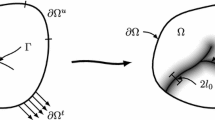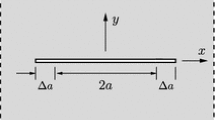Abstract
A 3-D ellipsoidal flaw model is sufficiently versatile to cover a wide variety of flaw shapes: existing 2-D flaw models are special cases. The energy release rate from an ellipsoidal flaw in an infinite medium may be calculated by both a ‘strain method’ and a ‘displacement method’. Solution techniques for both tension and compression are presented. The results calculated by both methods are in excellent agreement with available explicit results. The simpler and more efficient strain method is preferred in the calculation of the energy release rate for various flaws, except for line cracks and flat cracks subject to tensile stress normal to the crack plane. The 3-D formulation has considerable promise for providing understanding of the effects of various parameters on the energy release rate under triaxial stress states.
Similar content being viewed by others
References
R.A. Sack, The Proceedings of the Physical Society 58 (1946) 729–736.
B.J. Carter, E.Z. Lajtai and Y. Yuan, International Journal of Fracture 57 (1992) 221–236.
S.A.F. Murrell, British Journal of Applied Physics 15 (1964) 1195–1223.
G.C. Sih and H. Liebowitz, in Fracture, II, Academic Press, New York (1968) 68–190.
T.W. Lee and I.R. Grosse, Engineering Fracture Mechanics 44 (1993) 807–819.
T. Fett, Engineering Fracture Mechanics 32 (1989) 731–737.
G.H. Sohn and C.S. Hong, Engineering Fracture Mechanics 41 (1992) 177–190.
T.K. Hellen, International Journal for Numerical Methods in Engineering 9 (1975) 187–207.
H.G. DeLorenzi, Engineering Fracture Mechanics 21 (1985) 129–143.
E. Smith, International Journal of Fracture Mechanics 7 (1971) 339–342.
P.S. Theocaris, Engineering Fracture Mechanics 33 (1989) 205–214.
N.K. Hatzitrifon and E.E. Gdoutos, International Journal of Engineering Sciences 26 (1988) 833–836.
S.A.F. Murrell and P.J. Digby, Geophysical Journal (Royal Astronomical Society) 19 (1970) 309–334.
M.A. Sadowsky and E. Stemberg, Journal of Applied Mechanics 16 (1949) 149–157.
M. El-Rahman, Ph.D. thesis, The University of Calgary, Calgary (1989).
E.Z. Wang and N.G. Shrive, Engineering Fracture Mechanics 46 (1993) 15–26.
K. Robinson, Journal of Applied Physics 22 (1951) 1045–1054.
P.L. Key, International Journal of Fracture Mechanics 5 (1969) 287–296.
K. Palaniswamy and W.G. Knauss, in Mechanics Today, 4, Pergamon Press Inc., New York (1978) 87–148.
G.R. Irwin, Journal of Applied Mechanics 29 (1962) 651–654.
L. Mirandy and B. Paul, Journal of Engineering Materials and Technology 98 (1976) 164–172.
D.M. Parks, International Journal of Fracture 10 (1974) 487–502.
T.N. Farris and M. Liu, International Journal of Fracture 60 (1993) 33–47.
H. Liebowitz and E.T. MoyerJr, Computers & Structures 31 (1989) 1–9.
F.Z. Li, C.F. Shih and A. Needleman, Engineering Fracture Mechanics 21 (1985) 405–421.
P.W. Claydon, Engineering Fracture Mechanics 42 (1992) 961–969.
A. Bakker, International Journal of Fracture 23 (1983) R85–R90.
T.A. Cruse and G.J. Meyers, Journal of the Structural Division 103 (1977) 309–320.
H.G. DeLorenzi, International Journal of Fracture 19 (1982) 183–193.
J.R. Rice and D.C. Drucker, International Journal of Fracture mechanics 3 (1967) 19–27.
J.D. Eshelby, Proceedings of the Royal Society (London) A241 (1957) 376–396.
J.R. Rice, in Fracture, II, Academic Press, New York (1968) 191–313.
S.A.F. Murrell and P.J. Digby, International Journal of Fracture Mechanics 8 (1972) 167–173.
G.C. Sih and H. Liebowitz, International Journal of Solids and Structures 3 (1967) 1–22.
J. Glucklich, Journal of the Engineering Mechanics Division 89 (1963) 127–138.
A.E. Green and I.N. Sneddon, Proceedings of Cambridge Philosophical Society 46 (1950) 159–164.
M.K. Kassir and G.C. Sih, International Journal of Engineering Sciences 5 (1967) 899–918.
F. Erdogan and G.C. Sih, Journal of Basic Engineering 85 (1963) 519–525.
C.H. Wu, Journal of Elasticity 8 (1978) 235–257.
M. El-Rahman, M.Sci. thesis, The University of Calgary, Calgary (1983).
D.J. Holcomb, in Geomechanics, AMD/57, New York (1983) 11–21.
U. Diederichs, U. Schneider and M. Terrien, in Fracture Mechanics of Concrete, Elsevier, Amsterdam (1983) 157–206.
L.S. Costin, Journal of Geophysical Research 88 (1983) 9485–9492.
G.R. Holzhausen and A.M. Johnson, International Journal of Rock Mechanics and Mining Sciences 16 (1979) 163–177.
N.P. Bazant and J. Ozbolt, Journal of the Engineering Mechanics Division 118 (1992) 540–556.
N.G. Shrive and M. El-Rahman, Concrete International 7 (1985) 39–44.
Author information
Authors and Affiliations
Rights and permissions
About this article
Cite this article
Wang, E.Z., Shrive, N.G. A 3-D approach to the calculation of the energy release rate in some fracture problems. Int J Fract 66, 71–89 (1994). https://doi.org/10.1007/BF00012636
Received:
Accepted:
Issue Date:
DOI: https://doi.org/10.1007/BF00012636




